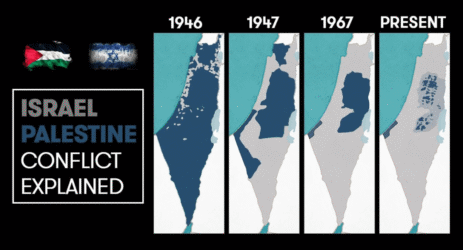Israel-Palestine conflict is a complex and deeply rooted issue that has persisted for decades.
It has its origins in the late 19th and early 20th centuries, and it continues to have a significant impact on the Middle East and beyond.
This blog will provide a comprehensive overview of the conflict, its historical background, key events, and potential paths to peace.
Introduction
The Israel–Palestine conflict is a long-standing and deeply entrenched dispute that centers around issues of territory, self-determination, and historical grievances.
It has been a source of tension and violence in the Middle East for over a century, with numerous failed attempts at resolution.
Understanding the historical context and key events that have shaped this conflict is essential for comprehending its complexities.
Israel-Palestine Conflict: Historical Background
The roots of the Israel-Palestine conflict can be traced back to the late 19th and early 20th centuries when the Zionist movement, advocating for a Jewish homeland, gained momentum.
At the same time, the Arab population in the region was also asserting its national identity. This resulted in a clash of national aspirations.
Key Events
- Balfour Declaration (1917): The Balfour Declaration, issued by the British government during World War I, expressed support for the establishment of a “national home for the Jewish people” in Palestine. This declaration laid the groundwork for future tensions.
- United Nations Partition Plan (1947): The United Nations proposed a partition plan that would divide Palestine into separate Jewish and Arab states. While accepted by Jewish leaders, Arab leaders rejected the plan, leading to a series of conflicts.
- 1948 Arab-Israeli War: Following Israel’s declaration of independence, neighboring Arab states launched an attack, resulting in a protracted war. The outcome of this war significantly shaped the territorial boundaries of Israel.
- Six-Day War (1967): Israel’s victory in the Six-Day War led to its occupation of the West Bank, Gaza Strip, and other territories. This event marked a turning point in the conflict, with long-term consequences.
- Oslo Accords (1993): The Oslo Accords aimed to establish a framework for peace negotiations. While they led to the creation of the Palestinian Authority, the core issues of the conflict remained unresolved.
- Second Intifada (2000): The Second Intifada, a Palestinian uprising, resulted in significant violence and casualties on both sides. It further strained efforts to achieve peace.
Current Situation
The conflict’s current status remains deeply divisive. Key issues include the establishment of a Palestinian state, borders, the status of Jerusalem, the right of return for Palestinian refugees, and security arrangements.
Multiple attempts to negotiate a two-state solution have failed, and violence continues to erupt sporadically.
Israel-Palestine Conflict: Potential Paths to Peace
While achieving a lasting peace in the Israel-Palestine conflict remains challenging, there are several potential paths to consider:
- Two-State Solution: This approach involves the establishment of an independent Palestinian state alongside Israel, with negotiated borders and a shared Jerusalem. However, obstacles like settlements, security, and the right of return have hindered progress.
- One-State Solution: Some advocate for a single, democratic state encompassing both Israelis and Palestinians. However, this approach raises concerns about the preservation of national identities and security.
- International Mediation: International bodies, such as the United Nations, could play a more significant role in mediating negotiations and ensuring compliance with agreements.
- Track II Diplomacy: Civil society and non-governmental organizations can facilitate dialogue and build trust between Israelis and Palestinians.
- People-to-People Initiatives: Grassroots efforts that bring together Israelis and Palestinians in various contexts, from education to business, can foster understanding and cooperation.
Conclusion
The Israel-Palestine conflict is a deeply rooted and multifaceted issue. Understanding its historical context, key events, and potential paths to peace is essential for anyone interested in its resolution.
While a peaceful resolution remains elusive, ongoing efforts at diplomacy, dialogue, and cooperation offer hope for a more stable and harmonious future in the region.
Note: The information above might not be accepted 100%. Please verify from your own sources.
For more News, please visit Munafa Marketing.




